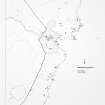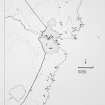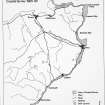Wick, Temperance Hall Park
Building (Period Unassigned), Font (Period Unassigned), Coin Hoard (Period Unassigned)
Site Name Wick, Temperance Hall Park
Classification Building (Period Unassigned), Font (Period Unassigned), Coin Hoard (Period Unassigned)
Alternative Name(s) Wic 170
Canmore ID 9230
Site Number ND35SE 9
NGR ND 3646 5105
Datum OSGB36 - NGR
Permalink http://canmore.org.uk/site/9230
- Council Highland
- Parish Wick
- Former Region Highland
- Former District Caithness
- Former County Caithness
ND35SE 9 3646 5105
(Area ND 3646 5105) Excavations in Temperance Hall Park, in June 1881, exposed the foundation of a building 'to all appearances a dwelling house' in which a supposed baptismal font (Beaton 1909) and a 15th century coin hoard were found. Renewed excavation led to the discovery on 10th March 1882 of a small bronze three-legged pot in close proximity to the find-spot of the coins 'in the remains of an old wall left standing when some excavations of last year (i.e. 1881) were completed for the site of a building being erected for Provost Rae' (Anon 1882). The 'font' was in the possession of ex-Bailie Simpson of Wick in 1909 (Beaton 1909).
The coins 'which had been enclosed in a receptacle of some kind, but which had quite disappeared' were dispersed among the workmen, but thirty gold and two silver coins were subsequently recovered as Treasure Trove. Twenty-nine gold coins were donated to the National Museum of Antiquities of Scotland (NMAS) by Lords Commissioners of the Treasury on 13th March 1882.
Of the 30 cold coins recovered, 16 were Scottish, 8 were English and 6 were French. The earliest ruler represented was Robert III of Scotland (1390-1406) and the latest were Edward IV of England and Louis XI of France (both 1461-83). (This suggests a date of deposit after 1461.) The 2 silver coins were Scottish (James II 1437-60) (Sim 1882).
The bronze pot 'corresponds in form and appearance with the three-legged pot in everyday use' except in size, being only 5ins high and 4 1/4ins in maximum diameter (Anon 1882).
The Temperance Hall stood at ND 3645 5108, and the only open area which could be called Temperance Hall Park in 1873 (OS 25" map, Caithness, 1873) lay to the E and S of the hall, bordering on the W side of Shore Lane and the N side of the High Street. At that date only the buildings at the N end of Shore Lane were in existence, so it is quite possible that in 1881-2 building was taking place in the lower part of Shore Lane or in the High Street.
It has been implied that this building might be the remains of the church which is alleged to have stood on Mounthalie (Beaton 1909) (ND35SE 10), but there is nothing to suggest that it might be ecclesiastical, apart from the alleged 'font' and the fact that the area was known as the Bishop's Land - probably a reference to 'the bishop's waste tenement on the east side of the town of Wick' which is mentioned in 1575 (OPS 1855).
Anon 1882; Proc Soc Antiq Scot 1882; G Sim 1882; Orig Paroch Scot 1855; D Beaton 1909.
No further information was found regarding this site. The area of Temperance Hall Park is built on, and the whereabouts of the remainder of the hoard, font and bronze pot are unknown.
Visited by OS (J B), 24 August 1982.
Project (1980 - 1982)




















